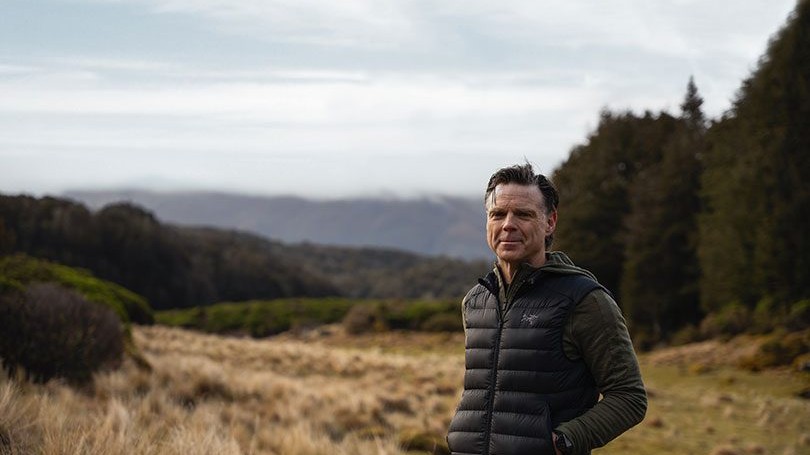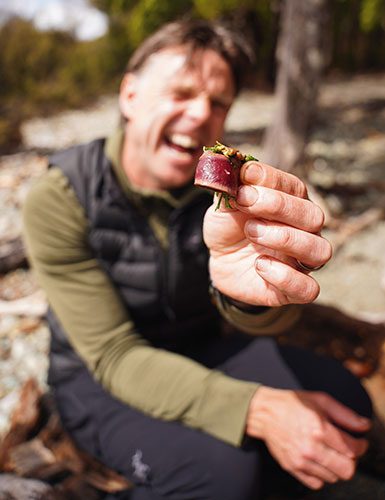As we wrap filming season 3 of A New Zealand Food Story, I’ve spent another year with phenomenal Kiwis who are growing, hunting, fishing, gathering and farming some of the world’s best ingredients. I am in a privileged position to be able to meet these great suppliers and help tell their unique stories. After all, as a chef the best way to be inspired and keep the creative juices flowing is not to look at Instagram but to carve out some time to visit – that’s where the real ideas form and a dish starts to make sense.
Cooking a delicious dish in a restaurant is just not enough these days and all those fancy cooking techniques that chefs use can go over the guest’s head. The restaurant game has changed and we now know the magic of food and the added value is in the story: the story of the people and the story of the ingredient. Who grew it? Why are you using it? Where in New Zealand does it come from? How did you find it? Our whole team at the restaurant [Ahi] can deliver these details to our guests, honouring the mahi of the producer. And the best way to gather this information is to make a visit.
Selfishly, when we set out to film season 3 of A New Zealand Food Story I had one eye on the restaurant and what we were cooking next. However, talking to a supplier on the phone and meeting them in their neck of the woods are two different things. When you visit, you find the real story and that story tells that it is tough out there right now.
We are a country of 5.2 million people and we produce enough food for 40 million people. That’s what we do in New Zealand: we make food. We are the great overachievers of food production for our size, with food representing 63% of our economy. And that’s before you count hospitality and tourism.
We have a beautiful and productive terroir positioned perfectly in Earth’s Goldilocks zone. It’s a long and thin country and as you descend the latitudes it’s so varied in soil types, air temperatures, climate, weather and humidity. An island nation surrounded by two vast oceans, we have it all and we can produce almost anything and everything, and we do it well.
It’s a big deal, but the reality is that some of our suppliers are struggling financially. Take for example our most-prized export: lamb. Farmers are only getting $6 a kilo at the farm gate for their lamb carcass weight this year, leaving them battling just to put diesel in their tractors and meet the high interest rates. So, why is this? What needs to change? How can our producers add value to their exported food, as we will all benefit if this happens.
There seems to be a disconnect between the producer and the consumer, both domestic and international. Just saying a product is made in New Zealand is no longer enough. Is it a race to the bottom, as we sell our food products as cheaply as possible overseas to compete with other countries in the international market? Or do we want to separate ourselves from the pack and race to be the best? While we need to think big, sometimes we are too busy just thinking how to get through today.
To add value we must tell our food story better and market ourselves more effectively overseas. Let’s tell the world about our food, let’s hero our great and diverse regions of New Zealand and introduce the actual people doing the mahi. Let’s follow the great example of New Zealand wine. Our food’s greatest value could be in its story, but we need more detail.
Our consumers are ready and waiting and they want to know more…
Episodes 1 and 2 of A New Zealand Food Story conveniently bookend our country. Episode 1, “The Far North”, and Episode 2, “The Deep South”, highlight two regions that could not be more different, showing our two extremes back-to-back. These two episodes demonstrate that celebrating our great diversity of people, places and products is key to understanding the full picture.
I always call the far north the forgotten province when it comes to food, but I think this is all about to change. An underlying theme of our visit is the climate and, yep you guessed it, it’s getting warmer. Our subtropical region of New Zealand is becoming more tropical. Some Northland growers are adapting quickly and getting a jump on the inevitable, exploring what the future could look like.
It’s now warm enough to grow peanuts commercially in the north. It’s a nut that grows like a potato, but is actually a legume. A chameleon of a plant and super-good for you, it’s full of good fats, carbs and protein and high in potassium and magnesium. Most interestingly, Northland farmers are giving their precious soils a break for a season to grow peanuts, fixing nitrogen like a cover crop and diversifying their income.
Another secret of the north is the tropical fruit: so many varieties of banana, pineapple, papaya and passionfruit, even a cassia bark plant and fresh cinnamon. Courageously leading the way are Sara Bennett and Andrew Withell from Aotearoa Grown. They run a unique experimental farm which makes you feel as though you are in the Amazon. The taste of their pineapples and bananas has especially left a mark on me – it will be impossible for me to eat imported fruit again.
In Fiordland for Episode 2, I ate my favourite dish of the season: the heart of a Wapiti elk, cooked by New Zealand’s most-admired game chef Dariush Lolaiy of Cazador. I am captivated as Dariush casually carves the heart muscle into three little pieces looking like flank steak, totally demystifying the ingredient and instantly making it look more approachable and easier to cook.
As he grills more of the game over the open fire, Dariush explains that Wapiti elk were introduced into Fiordland in 1905 as a gift to New Zealand from President Theodore Roosevelt. The elk thrived in their new environment and now the herd is closely managed by the Fiordland Wapiti Foundation, which has partnered with Dariush’s new wild food company, With Wild. Elk is one of the most nutritious meats we can eat and now you can eat it from the most pristine part of New Zealand. What a story; I am totally hooked. BEN BAYLY
Watch A New Zealand Food Story from 24 February at 7pm Saturdays on TVNZ1 & TVNZ+
SEE MORE FROM CUISINE
Flight of The Blue Duck
Dreams and determination have created a unique dining experience on a…
A magnificient table & A story of place
The world's newest Great Wine Capital takes the long-table lunch to…













